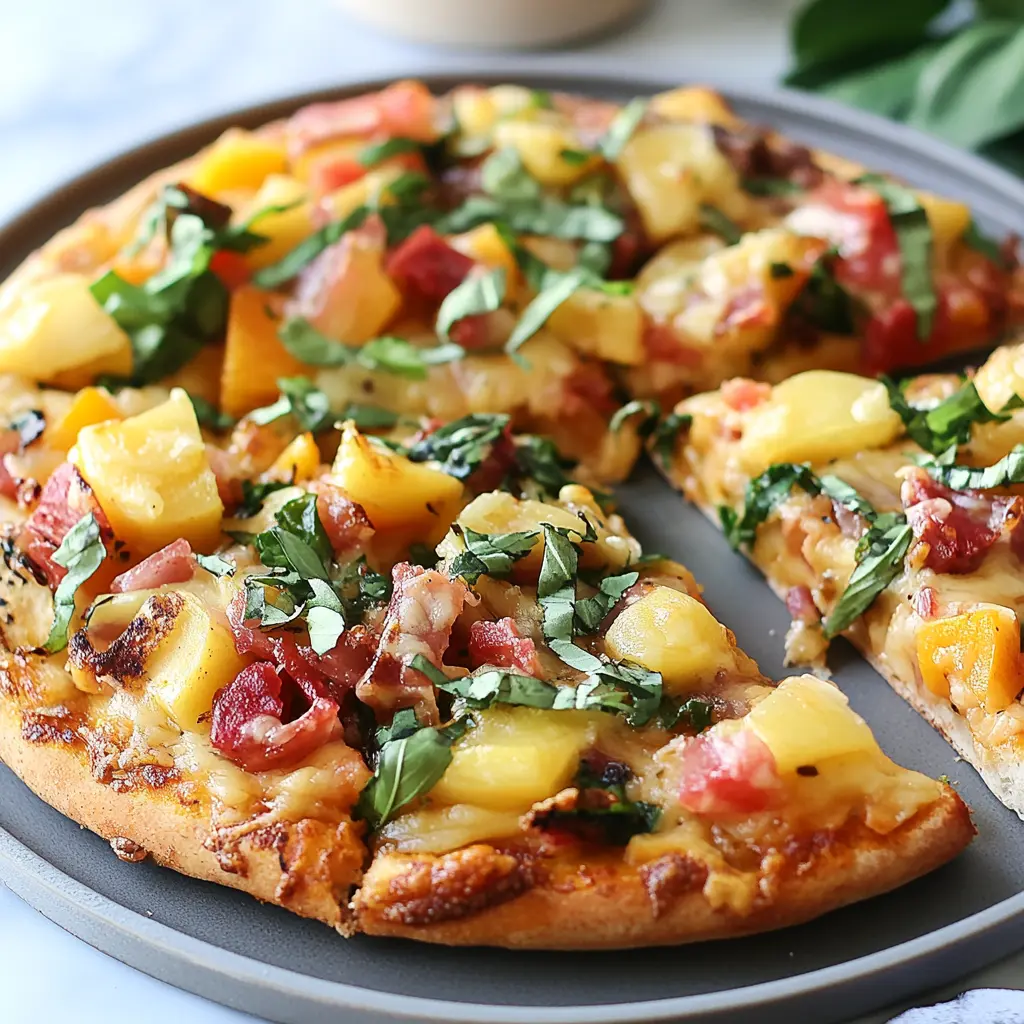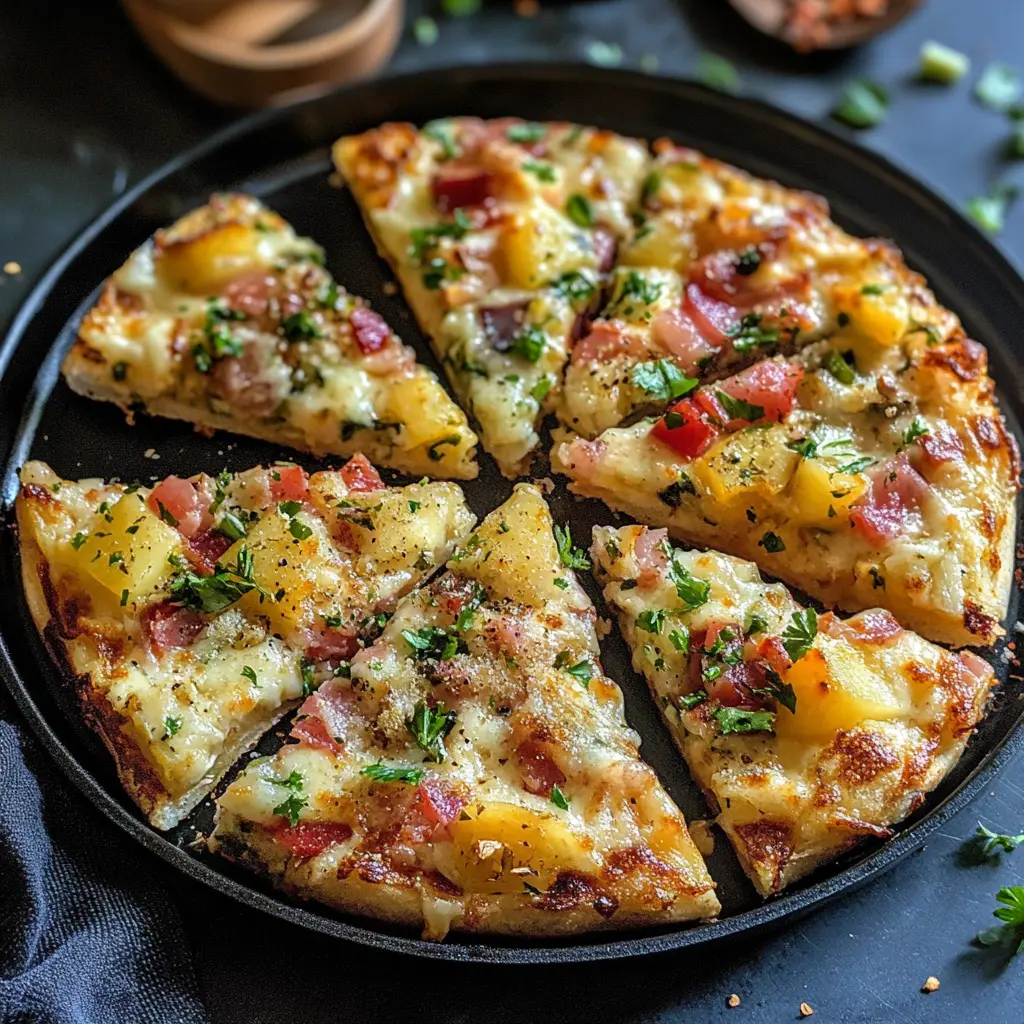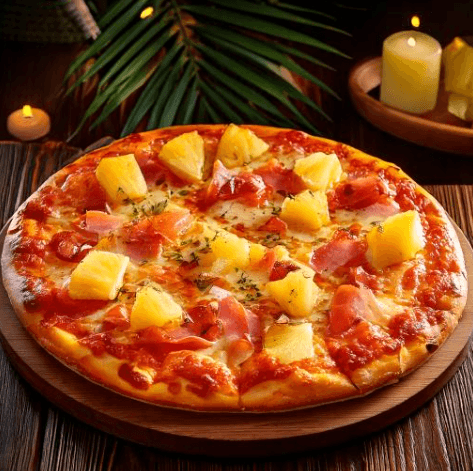Embrace the sweet and savory flavors of Hawaiian Pizza, a delightful blend of juicy pineapple, ham, and melted cheese atop a golden crust. This controversial yet beloved pizza variation combines the tropical zest of pineapple with the rich taste of smoked ham, creating a unique flavor profile that divides pizza lovers yet wins many hearts. Whether you’re a long-time fan or a curious newcomer, discover how to perfectly balance these bold toppings and why Hawaiian Pizza remains a staple in the world of unique culinary creations.
Hawaiian Pizza: The Sweet and Savory Icon That Changed Pizza Forever
Course: PizzaCuisine: CanadianDifficulty: MediumHawaiian pizza is a sweet and savory dish topped with ham, pineapple, cheese, and tomato sauce, offering a unique tropical twist.
Ingredients
For the Pizza Dough:
2 ¼ tsp (1 packet) active dry yeast
1 ½ cups warm water (110°F/45°C)
1 tbsp sugar
3 ½ cups all-purpose flour
1 tsp salt
2 tbsp olive oil
For the Sauce:
1 cup tomato-based pizza sauce (or BBQ sauce for a smoky variation)
1 tsp garlic powder
½ tsp oregano
For the Toppings:
Pineapple:
1 cup fresh pineapple chunks (preferred) or canned pineapple chunks (drained thoroughly)
Ham or Alternatives:
1 cup thinly sliced smoked or honey-glazed ham
Optional: Substitute ham with 1 cup crispy bacon bits, shredded chicken, marinated tofu, or jackfruit for variety.
Cheese:
1 ½ cups shredded mozzarella cheese
Optional: Add ½ cup shredded cheddar or a blend of mozzarella and provolone for a richer flavor.
Optional Garnishes:
Fresh basil leaves
Chili flakes
Drizzle of honey (optional, for added complexity)
Directions
- Step 1: Prepare the Dough
In a small bowl, mix warm water, sugar, and yeast. Let it sit for 5–10 minutes until frothy.
In a large mixing bowl, combine flour and salt. Add the yeast mixture and olive oil.
Knead the dough on a floured surface for 8–10 minutes until smooth and elastic.
Place the dough in a greased bowl, cover with a clean towel, and let it rise for 1–1.5 hours until doubled in size.
Step 2: Prepare the Sauce
In a small bowl, mix the pizza sauce with garlic powder and oregano for added flavor.
If using BBQ sauce, no additional seasoning is required.
Step 3: Assemble the Pizza
Preheat your oven to 475°F (245°C). If using a pizza stone, place it in the oven to heat.
Punch down the dough and divide it into two portions (for two medium pizzas). Roll out one portion on a floured surface to your desired thickness.
Transfer the rolled dough to a pizza peel or baking sheet lined with parchment paper.
Step 4: Add the Toppings
Spread a thin, even layer of sauce over the dough.
Sprinkle half of the shredded mozzarella evenly.
Arrange pineapple chunks and ham slices (or alternative toppings) over the cheese.
Add optional garnishes like chili flakes or honey drizzle.
Sprinkle the remaining cheese on top.
Step 5: Bake the Pizza
Transfer the pizza to the oven or onto the preheated pizza stone.
Bake for 10–12 minutes, or until the crust is golden and the cheese is bubbly and slightly browned.
Step 6: Garnish and Serve
Remove the pizza from the oven and let it cool for 2–3 minutes.
Add fresh basil leaves or an extra sprinkle of oregano before slicing.
Serve warm and enjoy the sweet-savory delight of homemade Hawaiian pizza! 🍕
Table of Contents
The Origins of Hawaiian Pizza
The origins trace back to 1962, when Sam Panopoulos, a Greek-Canadian restaurateur, decided to experiment with bold flavor combinations at his restaurant in Ontario, Canada. Inspired by the popularity of sweet-and-savory dishes in Asian cuisine, Panopoulos and his brothers decided to top a traditional pizza with canned pineapple and ham. The result was a unique dish that sparked curiosity and, eventually, a loyal following.
The name “Hawaiian” came not from the pizza’s origin but from the brand of canned pineapple they used. This simple branding decision played a pivotal role in shaping its identity and lending it a tropical connotation. While the pizza initially puzzled some customers, it gained traction as more people embraced the unexpected flavor combination. It was a reflection of the adventurous spirit of 1960s culinary experimentation, when chefs and home cooks alike were exploring new ways to innovate in the kitchen.
However, the initial reaction to Hawaiian pizza was not universally positive. Some traditionalists balked at the idea of combining fruit with pizza, a dish deeply rooted in savory flavors. Despite this skepticism, Hawaiian pizza’s unique profile resonated with diners seeking something fresh and different.
The Evolution of Hawaiian Pizza
From its humble beginnings in a small Canadian restaurant, Hawaiian pizza quickly began to gain popularity across North America. Its unusual flavor combination intrigued diners, and soon it became a staple offering in many pizzerias. The rise of frozen pizza in the 1970s also contributed to its spread, as major brands began incorporating Hawaiian pizza into their product lines.
As Hawaiian pizza’s reputation grew, it began to adapt to local tastes in different countries. In Australia, it became a household favorite and remains one of the most popular pizza varieties to this day. In Sweden, a version called “Tropicana” adds bananas to the mix, showcasing how international interpretations have taken the concept even further.
Despite its global success, Hawaiian pizza continues to ignite debates about what defines a “true” pizza. However, its enduring appeal lies in its ability to blend opposites—sweetness with saltiness, juiciness with crunchiness—into a culinary experience that is anything but ordinary. Hawaiian pizza’s journey from a small Canadian experiment to a worldwide phenomenon underscores the power of creativity in cuisine, proving that sometimes, breaking the rules can lead to delicious results.
Additional Topics
1. Customizing Your Hawaiian pizza
- Spicy Hawaiian Pizza
Add sliced jalapeños or drizzle with hot honey for a fiery twist. - Vegetarian Hawaiian Pizza
Replace ham with roasted bell peppers or caramelized onions for a plant-based version. - BBQ Hawaiian Pizza
Swap traditional pizza sauce with barbecue sauce, and add crispy bacon for extra smoky flavor.
2. Nutritional Tips
While Hawaiian pizza can be indulgent, small tweaks can make it healthier:
- Use a whole wheat crust for added fiber.
- Opt for fresh pineapple instead of canned to reduce sugar.
- Add more vegetables, like spinach or mushrooms, for extra nutrients.
3. Pairing Ideas
Hawaiian pizza pairs wonderfully with sides and beverages:
- Sides: Serve with a light arugula salad or crispy garlic bread.
- Beverages: Pair with a fruity Riesling, crisp Sauvignon Blanc, or a refreshing lager

Popularity and Cultural Impact
Hawaiian pizza, despite its name, originated in Canada and has since gained worldwide recognition as a controversial yet beloved dish. Its unique combination of sweet pineapple and savory ham has made it a standout choice in the global pizza landscape.
Popular Regions for Hawaiian Pizza:
Hawaiian pizza is particularly popular in North America, Australia, and parts of Europe. In the United States and Canada, it enjoys a loyal fan base as a staple on most pizzeria menus. Australia has embraced Hawaiian pizza enthusiastically, where it’s one of the most commonly ordered varieties. In Europe, while preferences vary, the pizza’s appeal continues to grow, especially in countries like the UK and Germany, where adventurous toppings are celebrated.
Factors Contributing to Its Fame:
The fame of Hawaiian pizza can be attributed to its novelty and balance of flavors. The contrasting sweet and savory elements intrigue diners seeking something different from traditional options. Moreover, its affordability and widespread availability have contributed to its popularity. The heated debates over whether pineapple belongs on pizza have also boosted its visibility, making it a topic of conversation across social media and dinner tables alike.
Cultural Impact
Hawaiian pizza’s cultural significance extends beyond the dining table, leaving a lasting impression on modern pop culture. It has become a symbol of culinary experimentation and an emblem of polarizing food preferences.
Memes, Jokes, and Debates:
Hawaiian pizza has become a frequent subject of internet memes and jokes, often sparking playful debates. The question, “Does pineapple belong on pizza?” has become a cultural phenomenon, dividing pizza lovers into passionate camps. Social media platforms teem with humorous posts and polls about this topic, keeping Hawaiian pizza perpetually relevant in online discourse. Even celebrities and politicians have chimed in, further fueling the debate and elevating its status in pop culture.
Representation in Media and Pop Culture:
Hawaiian pizza has appeared in various forms of media, including television shows, movies, and advertisements, often as a shorthand for quirky or unconventional choices. For instance, characters in sitcoms may be shown arguing about pineapple on pizza, reflecting real-world debates. In animated series, Hawaiian pizza is sometimes used as a humorous prop to showcase eccentric personalities or cultural diversity.
Additionally, Hawaiian pizza has been featured in culinary competitions and food documentaries, often highlighting its origin story and the creative leap that made it a global sensation. Its ability to spark debates has even been likened to broader cultural discussions about tradition versus innovation.
Hawaiian pizza’s enduring popularity and cultural impact stem from its unique flavor profile and the conversations it sparks. Whether you love it or loathe it, Hawaiian pizza has transcended its role as a mere food item to become a cultural icon, uniting and dividing food enthusiasts worldwide. Through its global reach, comedic portrayals, and ongoing debates, Hawaiian pizza continues to carve out a special place in both culinary history and contemporary culture.
Variations and Innovations: Creative Hawaiian Pizza Variations
With its sweet pineapple and savory ham combination, has become a global sensation. However, this classic flavor profile is ripe for innovation. Here are some creative twists that cater to diverse palates and culinary trends:
Regional Twists
- BBQ Hawaiian Pizza
Infuse smoky sweetness into the classic Hawaiian pizza by swapping traditional tomato sauce with tangy barbecue sauce. Add grilled chicken or smoked pork for an extra layer of flavor. - Spicy Hawaiian Pizza
Add a kick to the sweetness of pineapple by including jalapeños, red chili flakes, or a drizzle of hot honey. This variation appeals to those who love a fiery edge. - Tropical Hawaiian Pizza
Elevate the tropical theme by incorporating mango or passion fruit chunks alongside the pineapple. Pair it with prosciutto or crispy bacon for a unique take. - Island-Inspired Hawaiian Pizza
Use a coconut milk-based sauce and sprinkle shredded coconut over the cheese for an island-inspired twist. This combination pairs beautifully with pineapple and ham.
Gourmet Versions Using Artisan Ingredients
- Truffle Hawaiian Pizza
Upgrade the classic recipe with truffle oil, goat cheese, and thinly sliced prosciutto. The earthiness of the truffle balances the sweetness of the pineapple. - Herb-Infused Hawaiian Pizza
Use fresh herbs like basil or cilantro to add brightness and freshness to the dish. These can be sprinkled on top after baking for a gourmet touch. - Smoked Ham and Aged Cheese
Replace regular ham with smoked or honey-glazed ham and use aged cheddar or Gruyère for a deeper, richer flavor.
Fusion Creations: Inspired Dishes
Hawaiian pizza has inspired countless fusion dishes that bring its signature flavors to new culinary contexts:
- Hawaiian Burgers
Stack a beef or plant-based patty with grilled pineapple, ham, and mozzarella cheese. Add a slather of barbecue sauce for a delightful burger twist. - Hawaiian Sushi
Roll pineapple, ham, and mozzarella cheese inside sushi rice and seaweed. Finish with a drizzle of teriyaki or spicy mayo for a bold fusion creation. - Hawaiian Tacos
Use soft tortillas to hold a filling of grilled pineapple, shredded ham, and melted cheese. Garnish with cilantro and lime for a zesty finish. - Hawaiian Salad
Combine greens with pineapple chunks, crispy ham strips, mozzarella shreds, and a light balsamic glaze for a refreshing salad inspired by Hawaiian pizza.
Frequently Asked Questions (FAQs)
1. Why is it called Hawaiian pizza?
Is named for its signature topping of pineapple, which is commonly associated with Hawaii. However, the name is more about the tropical imagery linked to pineapples than the actual origin of the pizza itself.
2. Was Hawaiian pizza really invented in Hawaii?
No, was not invented in Hawaii. It was actually created by Sam Panopoulos, a Greek-born Canadian, in 1962 at the Satellite Restaurant in Ontario, Canada. Panopoulos experimented with adding canned pineapple to pizza to see how it would taste.
3. What makes Hawaiian pizza controversial?
Pineapple on pizza sparks controversy due to its polarizing nature. While some people adore the sweet and savory flavor combination, others firmly argue that fruit has no place on a pizza. As a result, this debate has fueled lively cultural discussions and continues to divide opinions across the globe.
4. What are good alternatives for pineapple if I don’t like it?
If you’re not a fan of pineapple but still want to include a fruity element, you can consider alternatives like mango, peach, or even apple for a unique type of sweetness. Additionally, grilling or caramelizing each of these toppings beforehand can enhance their flavor, adding depth to the overall taste of the pizza. Furthermore, these methods bring out the natural sugars, making the fruit even more delicious and complementary to the other toppings.
5. How do I make a gluten-free Hawaiian pizza?
To make a gluten-free Hawaiian pizza, start with a gluten-free pizza base, which can be bought from most supermarkets or made at home using gluten-free flour. Use gluten-free ham or Canadian bacon, and ensure that any other toppings or sauces (like pizza sauce) are certified gluten-free. Follow the rest of your pizza recipe as usual, substituting only the ingredients that contain gluten.
Discover More Delicious Pizza Options
Click on the name of recipe for more information:
Pizza Edition: Exploring Flavors, Recipes, and Global Trends
Mediterranean Pizza: Recipes, and More.
Breakfast Pizza: Delicious Recipes and Tips
Conclusion: Hawaiian Pizza
Hawaiian pizza is more than just a dish—it’s a culinary icon that sparks strong opinions and endless debates. Its creation marked a turning point in pizza history, proving that bold experimentation could redefine traditional food norms. By combining the tangy sweetness of pineapple with the salty richness of ham, this pizza introduced a flavor profile that remains one of the most polarizing in the world.
From its humble beginnings in a small Canadian restaurant, Hawaiian pizza has become a global phenomenon. It’s a staple on menus across North America, Australia, and Europe, adored by those who appreciate its sweet-and-savory combination. Its journey reflects the power of culinary creativity and the willingness of people to embrace new ideas, even when they challenge long-held traditions.
Hawaiian pizza’s cultural impact is undeniable. It has transcended its role as a meal to become a symbol of personal preference, inspiring heated debates, memes, and pop culture references. Whether you love it or question its place in the pizza pantheon, Hawaiian pizza never fails to elicit a reaction, making it one of the most talked-about dishes of all time.
Beyond the controversy, Hawaiian pizza offers versatility and a sense of fun. It’s perfect for adventurous eaters, casual dinners, or light-hearted gatherings where food sparks conversation. Its balance of flavors pairs well with a variety of beverages, from tropical cocktails to crisp lagers, making it a standout choice for diverse occasions.
Reminds us that food is deeply personal yet universally uniting. Its journey from a bold experiment to a worldwide favorite showcases how one dish can capture hearts and palates across the globe. Whether you’re a fan or a skeptic, Hawaiian pizza undeniably holds a place in culinary history.


